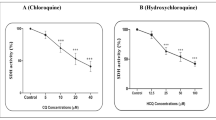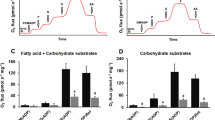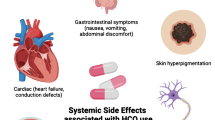Abstract
Chloroquine (CQ) and hydroxychloroquine (HCQ) are classical antimalarial drugs, and recently have been used for other applications including coronavirus disease 2019 (COVID-19). Although they are considered safe, cardiomyopathy may associate CQ and HCQ applications particularly at overdoses. The goal of the present study was to evaluate the potential protective effect of the nootropic agent vinpocetine against CQ and HCQ adverse effects with a specific focus on the heart. For this purpose, a mouse model of CQ (0.5 up to 2.5 g/kg)/HCQ (1 up to 2 g/kg) toxicity was used, and the effect of vinpocetine was evaluated by survival, biochemical, as well as histopathological analyses. Survival analysis revealed that CQ and HCQ caused dose-dependent lethality, which was prevented by co-treatment with vinpocetine (100 mg/kg, oral or intraperitoneal). To gain deeper understanding, a dose of 1 g/kg CQ—which did not cause death within the first 24 h after administration—was applied with and without vinpocetine administration (100 mg/kg, intraperitoneal). The CQ vehicle group showed marked cardiotoxicity as evidenced by significant alterations of blood biomarkers including troponione-1, creatine phosphokinase (CPK), creatine kinase-myocardial band (CK-MB), ferritin, and potassium levels. This was confirmed at the tissue level by massive alteration of the heart tissue morphology and coincided with massive oxidative stress. Interestingly, co-administration of vinpocetine strongly ameliorated CQ-induced alterations and restored the antioxidant-defense system of the heart. These data suggest that vinpocetine could be used as an adjuvant therapy together with CQ/HCQ applications.







Similar content being viewed by others
Data availability
The data presented in this manuscript are available upon request.
Abbreviations
- CQ:
-
Chloroquine
- HCQ:
-
Hydroxychloroquine
- Vin:
-
Vinpocetine
- CK:
-
Total creatinine kinase
- CK-MB:
-
Creatine kinase-MB
- PBS:
-
Phosphate-buffered saline
- MDA:
-
Malondialdehyde
- GSH:
-
Glutathione
- SOD:
-
Superoxide dismutase
- PO:
-
Per os
- IP:
-
Intraperitoneal
- BID:
-
Two times a day
References
Abu-Aisha H, Abu-Sabaa HM, Nur T (1979) Cardiac arrest after intravenous chloroquine injection. J Trop Med Hyg 82(2):36–37
Browning DJ (2014) Pharmacology of chloroquine and hydroxychloroquine. In: Browning DJ (ed) Hydroxychloroquine and chloroquine retinopathy. Springer, New York, pp 35–63
Cortegiani A, Ingoglia G, Ippolito M, Giarratano A, Einav S (2020) A systematic review on the efficacy and safety of chloroquine for the treatment of COVID-19. J Crit Care 57:279–283. https://doi.org/10.1016/j.jcrc.2020.03.005
Isaksen JL, Holst AG, Pietersen A, Nielsen JB, Graff C, Kanters JK (2020) Chloroquine, but not hydroxychlorquine, prolongs the QT interval in a primary care population. https://doi.org/10.1101/2020.06.19.20135475
Jankelson L, Karam G, Becker ML, Chinitz LA, Tsai MC (2020) QT prolongation, torsades de pointes, and sudden death with short courses of chloroquine or hydroxychloroquine as used in COVID-19: a systematic review. Heart Rhythm. https://doi.org/10.1016/j.hrthm.2020.05.008
Jeon KI, Xu X, Aizawa T et al (2010) Vinpocetine inhibits NF-kappaB-dependent inflammation via an IKK-dependent but PDE-independent mechanism. Proc Natl Acad Sci U S A 107(21):9795–9800. https://doi.org/10.1073/pnas.0914414107
Joyce E, Fabre A, Mahon N (2013) Hydroxychloroquine cardiotoxicity presenting as a rapidly evolving biventricular cardiomyopathy: key diagnostic features and literature review. Eur Heart J Acute Cardiovasc Care 2(1):77–83. https://doi.org/10.1177/2048872612471215
Kamp TJ, Hamdan MH, January CT (2020) Chloroquine or hydroxychloroquine for COVID-19: is cardiotoxicity a concern? J Am Heart Assoc 9(12):e016887. https://doi.org/10.1161/jaha.120.016887
Klouda CB, Stone WL (2020) Oxidative stress, proton fluxes, and chloroquine/hydroxychloroquine treatment for COVID-19. Antioxidants (basel) 9(9):894. https://doi.org/10.3390/antiox9090894
Kumar Mishra S, Singh P, Rath SK (2013) Protective effect of quercetin on chloroquine-induced oxidative stress and hepatotoxicity in mice. Malar Res Treat. https://doi.org/10.1155/2013/141734
Lohmann A, Dingler E, Sommer W, Schaffler K, Wober W, Schmidt W (1992) Bioavailability of vinpocetine and interference of the time of application with food intake. Arzneimittelforschung 42(7):914–917
Lourenco-Gonzalez Y, Fattori V, Domiciano TP et al (2019) Repurposing of the nootropic drug vinpocetine as an analgesic and anti-inflammatory agent: evidence in a mouse model of superoxide anion-triggered inflammation. Mediators Inflamm 2019:6481812. https://doi.org/10.1155/2019/6481812
Meo SA, Klonoff DC, Akram J (2020) Efficacy of chloroquine and hydroxychloroquine in the treatment of COVID-19. Eur Rev Med Pharmacol Sci 24(8):4539–4547. https://doi.org/10.26355/eurrev_202004_21038
Panda PK, Ramachandran A, Panda P, Sharawat IK (2022) Safety and efficacy of vinpocetine as a neuroprotective agent in acute ischemic stroke: a systematic review and meta-analysis. Neurocrit Care 37(1):314–325. https://doi.org/10.1007/s12028-022-01499-y
Plantone D, Koudriavtseva T (2018) Current and future use of chloroquine and hydroxychloroquine in infectious, immune, neoplastic, and neurological diseases: a mini-review. Clin Drug Investig 38(8):653–671. https://doi.org/10.1007/s40261-018-0656-y
Ramezani-Aliakbari F, Badavi M, Dianat M, Mard SA, Ahangarpour A (2019) The effects of trimetazidine on QT-interval prolongation and cardiac hypertrophy in diabetic rats. Arq Bras Cardiol 112(2):173–178. https://doi.org/10.5935/abc.20180248
Rosenberg ES, Dufort EM, Udo T et al (2020) Association of treatment with hydroxychloroquine or azithromycin with in-hospital mortality in patients with COVID-19 in New York State. JAMA. https://doi.org/10.1001/jama.2020.8630
Ruiz-Miyazawa KW, Pinho-Ribeiro FA, Zarpelon AC et al (2015) Vinpocetine reduces lipopolysaccharide-induced inflammatory pain and neutrophil recruitment in mice by targeting oxidative stress, cytokines and NF-kappaB. Chem Biol Interact 237:9–17. https://doi.org/10.1016/j.cbi.2015.05.007
Saleh M, Gabriels J, Chang D et al (2020) Effect of chloroquine, hydroxychloroquine, and azithromycin on the corrected QT interval in patients with SARS-CoV-2 infection. Circ Arrhythm Electrophysiol 13(6):e008662. https://doi.org/10.1161/CIRCEP.120.008662
Shah S, Das S, Jain A, Misra DP, Negi VS (2020) A systematic review of the prophylactic role of chloroquine and hydroxychloroquine in coronavirus disease-19 (COVID-19). Int J Rheum Dis 23(5):613–619. https://doi.org/10.1111/1756-185X.13842
Wang H, Zhang K, Zhao L, Tang J, Gao L, Wei Z (2014) Anti-inflammatory effects of vinpocetine on the functional expression of nuclear factor-kappa B and tumor necrosis factor-alpha in a rat model of cerebral ischemia-reperfusion injury. Neurosci Lett 566:247–251. https://doi.org/10.1016/j.neulet.2014.02.045
Wang M, Cao R, Zhang L et al (2020) Remdesivir and chloroquine effectively inhibit the recently emerged novel coronavirus (2019-nCoV) in vitro. Cell Res 30(3):269–271
Warhurst DC, Steele JCP, Adagu IS, Craig JC, Cullander C (2003) Hydroxychloroquine is much less active than chloroquine against chloroquine-resistant Plasmodium falciparum, in agreement with its physicochemical properties. J Antimicrob Chemother 52(2):188–193. https://doi.org/10.1093/jac/dkg319
Zhang L, Yang L (2014) Anti-inflammatory effects of vinpocetine in atherosclerosis and ischemic stroke: a review of the literature. Molecules 20(1):335–347. https://doi.org/10.3390/molecules20010335
Zhang YS, Li JD, Yan C (2018) An update on vinpocetine: new discoveries and clinical implications. Eur J Pharmacol 819:30–34. https://doi.org/10.1016/j.ejphar.2017.11.041
Author information
Authors and Affiliations
Corresponding author
Ethics declarations
Conflict of interest
The authors declare no conflict of interest.
Additional information
Publisher's Note
Springer Nature remains neutral with regard to jurisdictional claims in published maps and institutional affiliations.
Rights and permissions
Springer Nature or its licensor (e.g. a society or other partner) holds exclusive rights to this article under a publishing agreement with the author(s) or other rightsholder(s); author self-archiving of the accepted manuscript version of this article is solely governed by the terms of such publishing agreement and applicable law.
About this article
Cite this article
Abdelmageed, N., Twafik, W.AA., Morad, O.AR. et al. Vinpocetine protects against chloroquine-induced cardiotoxicity by mitigating oxidative stress. Arch Toxicol 97, 2763–2770 (2023). https://doi.org/10.1007/s00204-023-03546-9
Received:
Accepted:
Published:
Issue Date:
DOI: https://doi.org/10.1007/s00204-023-03546-9




